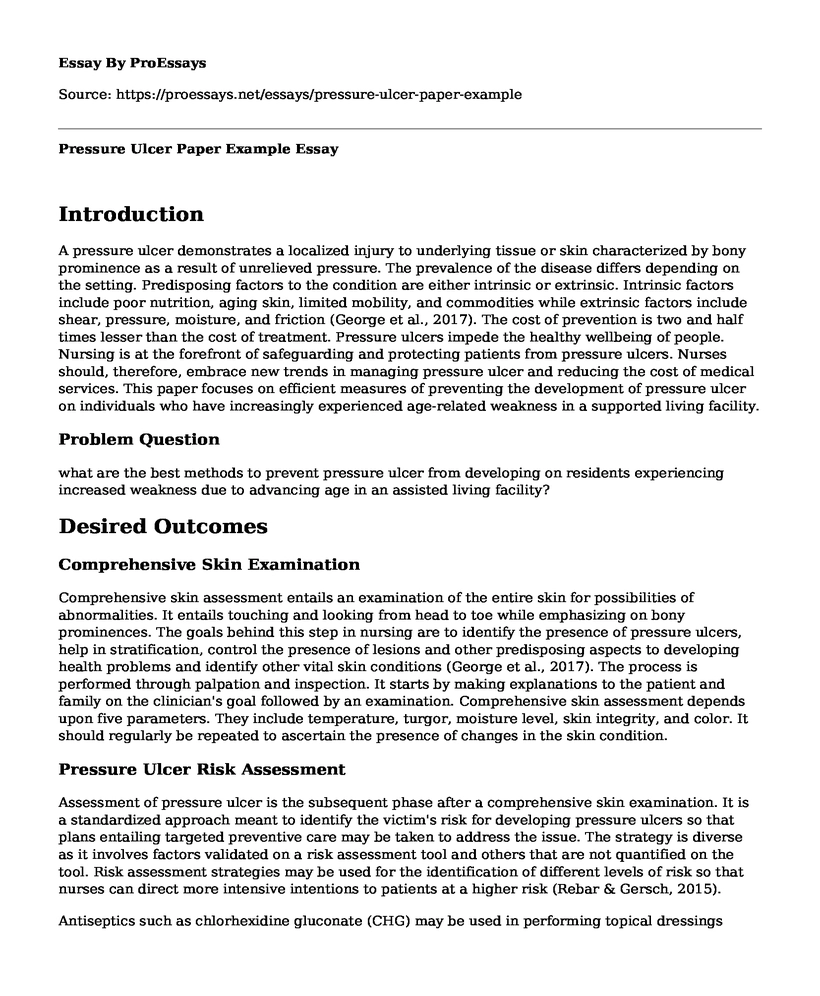Introduction
A pressure ulcer demonstrates a localized injury to underlying tissue or skin characterized by bony prominence as a result of unrelieved pressure. The prevalence of the disease differs depending on the setting. Predisposing factors to the condition are either intrinsic or extrinsic. Intrinsic factors include poor nutrition, aging skin, limited mobility, and commodities while extrinsic factors include shear, pressure, moisture, and friction (George et al., 2017). The cost of prevention is two and half times lesser than the cost of treatment. Pressure ulcers impede the healthy wellbeing of people. Nursing is at the forefront of safeguarding and protecting patients from pressure ulcers. Nurses should, therefore, embrace new trends in managing pressure ulcer and reducing the cost of medical services. This paper focuses on efficient measures of preventing the development of pressure ulcer on individuals who have increasingly experienced age-related weakness in a supported living facility.
Problem Question
what are the best methods to prevent pressure ulcer from developing on residents experiencing increased weakness due to advancing age in an assisted living facility?
Desired Outcomes
Comprehensive Skin Examination
Comprehensive skin assessment entails an examination of the entire skin for possibilities of abnormalities. It entails touching and looking from head to toe while emphasizing on bony prominences. The goals behind this step in nursing are to identify the presence of pressure ulcers, help in stratification, control the presence of lesions and other predisposing aspects to developing health problems and identify other vital skin conditions (George et al., 2017). The process is performed through palpation and inspection. It starts by making explanations to the patient and family on the clinician's goal followed by an examination. Comprehensive skin assessment depends upon five parameters. They include temperature, turgor, moisture level, skin integrity, and color. It should regularly be repeated to ascertain the presence of changes in the skin condition.
Pressure Ulcer Risk Assessment
Assessment of pressure ulcer is the subsequent phase after a comprehensive skin examination. It is a standardized approach meant to identify the victim's risk for developing pressure ulcers so that plans entailing targeted preventive care may be taken to address the issue. The strategy is diverse as it involves factors validated on a risk assessment tool and others that are not quantified on the tool. Risk assessment strategies may be used for the identification of different levels of risk so that nurses can direct more intensive intentions to patients at a higher risk (Rebar & Gersch, 2015).
Antiseptics such as chlorhexidine gluconate (CHG) may be used in performing topical dressings whenever there is the need for them. CHG and iodine play a crucial role in reducing the risks of surgical site infection (Darouiche et al., 2010). However, CHG is more rapid when in use. They are usually prescribed as anti-bacterial chemicals. They play a role in reducing the spread of infection, hence acting as a preventive measure. CHG should be used before performing any surgical prep.
Significance of Pressure Ulcer to Nursing Profession
Pressure ulcer risk assessment is vital in nursing because of some reasons. First, it helps in the making of decisions. In most cases, clinicians lack skills in identifying patients risk for developing pressure ulcers. The incorporation of a standardized risk assessment tool aids in directing the process by enhancing the capability of identifying individual's at risk and quantifying the level of risk (Rebar & Gersch, 2015). Second, an assessment exercise guides nurses in selectively targeting preventive interventions. Prevention of ulcers depends on resources. Hence, resources need to be channeled to people who are at the greatest risk of developing the condition. Pressure ulcer risk assessment relies on tools that have been validated in the identification of people at risk. Some of the dimensions relied upon include nutrition, mobility, and moisture. Norton and Braden's scales are reliable and valid. They can provide valuable data for planning care if used correctly.
Methods for Disseminating Research Findings
All members of staff should be aware of the patient's status on pressure ulcer risk. The methods of disseminating results include documentation, incorporation in the flowchart and oral communication. Aside from documentation in the patient's medical records, the results should be incorporated into the day-to-day patient flow sheet, and be included in the patient report (Rebar & Gersch, 2015). Documentation of the findings enhances the level of efficiency in treating patients. It is generally vital in the prevention and treatment of pressure ulcers. Incorporation of the findings in the day to day checkup enhances the level of awareness among health practitioners on a daily basis. Oral communication during shift change is also appropriate for purposes of review on records and flow-sheets.
References
Darouiche, R., Wall, M., Itani, K., Otterson, M., Berger, D. (January 2010). Chlorhexidine alcohol versus povidone iodine for surgical site antisepsis. New England Journal of Medicine. doi:10.1056/NEJMoa0810988
George, J., Klika, A. K., & Higuera, C. A. (2017). Use of Chlorhexidine Preparations in Total Joint Arthroplasty. Journal of Bone and Joint Infection, 2(1), 15-22. http://doi.org/10.7150/jbji.16934.
Rebar, Cherie & Gersch, Carolyn. (2015). Understanding research for evidence-based practice (4th ed.). Wolters Kluwer. Philadelphia, PA.
Cite this page
Pressure Ulcer Paper Example. (2022, Jul 03). Retrieved from https://proessays.net/essays/pressure-ulcer-paper-example
If you are the original author of this essay and no longer wish to have it published on the ProEssays website, please click below to request its removal:
- Example of Speech on Obesity
- Vestibular Rehabilitation Essay
- Essay Sample on Healthcare Revenue Cycle Management
- Ethical Considerations for Adopting Electronic Records in Nursing Essay
- Research Paper on Stroke: A Leading Cause of Death & Disability in US
- Abortion: A Controversial Issue Open to Debate and Discussion - Essay Sample
- Parents' Distress in Children With Asthma: Examining Complexity - Research Paper







